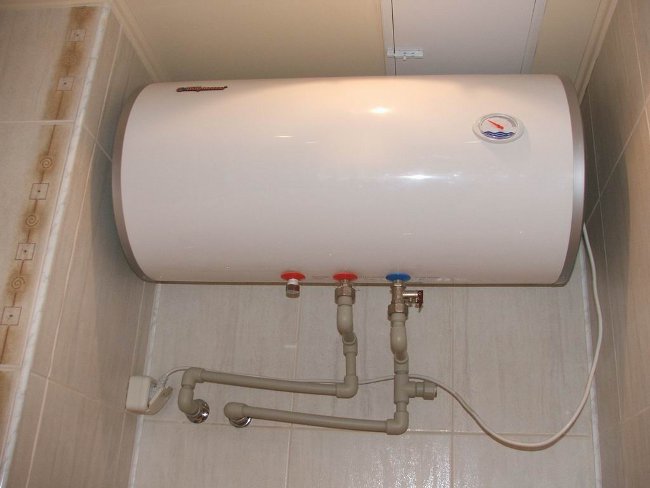Storage tank for hot and cold water: what is it and how does it work. Storage tank for water supply: varieties, selection and connection
In what cases is a water supply system with a storage device used? What kind of storage tanks can be used to ensure uninterrupted water supply? What piping is needed for the storage tank? Today we have to find answers to these and some other questions.
Types of containers and the purpose of their use
First, let's define the terminology.
Under the storage capacity in relation to water supply can be understood:
| Image | Description |
|
|
It provides water supply with overpressure, which is provided by an air reservoir in its body. It is used as a backup source of water, as well as a buffer tank in an autonomous water supply system with water supply from a well or a well: the hydraulic accumulator smooths out pressure surges when the pump is turned on and makes these inclusions more rare, saving the device's life. |
|
|
It favorably differs from the flow one in lower requirements to the power of the heat source. The boiler can have its own heating elements (tubular electric heaters) or use a coolant circulating in a closed circuit between it and the boiler (the so-called indirect heating boiler) to heat water. |
|
|
Unlike a hydraulic accumulator, the pressure in the water supply system is created only due to the difference in height between the water level in the tank and the draw-off points, so storage tanks are usually installed in an insulated attic or under the ceiling of a residential floor. |
Selection and installation
Now let's find out how the water supply scheme with storage capacity is implemented in each case.
Hydraulic accumulator
The main elements of the accumulator are a steel tank with an elastic membrane dividing it into air and water reservoirs, and a nipple for pumping air. The accumulator can be connected to any point of the water supply.
When used in an autonomous water supply scheme, it additionally includes:
- Pump with pressure sensor and control automation. The task of automatic control of the device is to turn it on when the pressure drops to the lower critical level and turn off when the upper threshold set by the owner is reached;
- Check valve. It does not allow the water in the accumulator with excess pressure to drain back into the well.
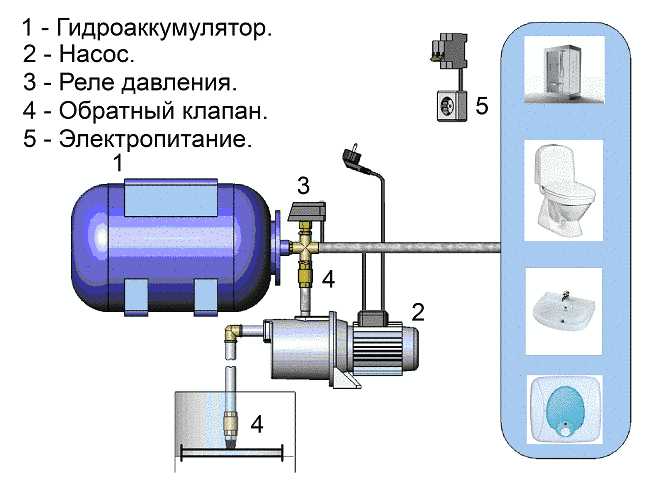
Please note: the nominal capacity of the accumulator is not equal to the amount of water that it can hold. 100-liter storage tanks that provide uninterrupted water supply can hold only 30-40 liters of water; the rest of the volume of the tank is occupied by air or nitrogen, which is safer in terms of protecting steel from corrosion.
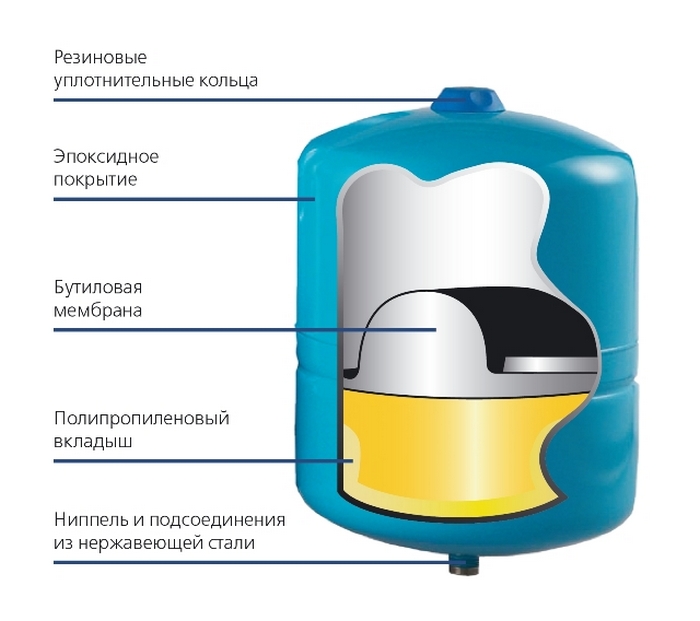
Boiler
As we have already found out, a hot water storage tank can use its own heat source (electric heating element) or water heating through a heat exchanger from a heating boiler. An indirect heating boiler paired with a gas boiler is much more profitable than an electric one: it provides the cost of a kilowatt-hour of heat at only 50-70 kopecks against 4-5 rubles per kilowatt-hour of electricity.
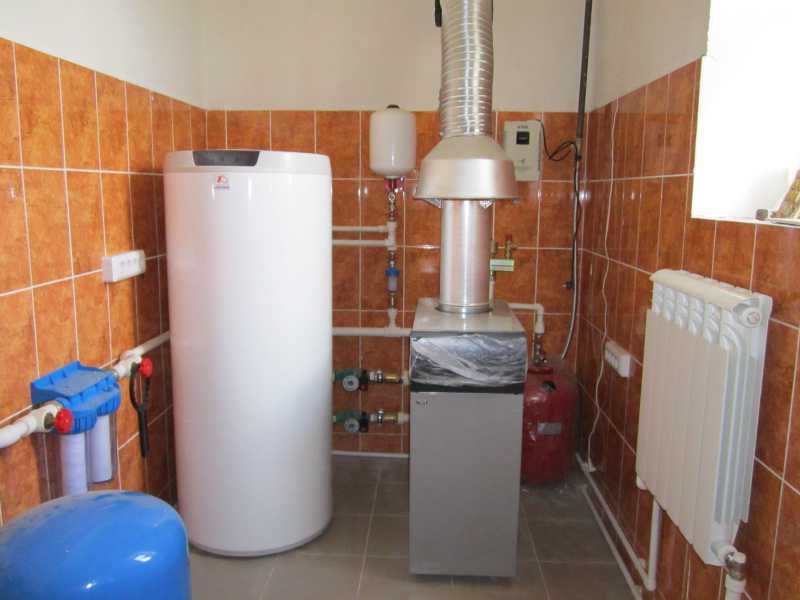
Reference: the thermal power of any direct heating electrical appliance is exactly equal to its electrical power. The so-called economical heaters are nothing more than marketing tales designed to boost sales.
How to connect the boiler to the water supply?
It is mounted between the cold and hot water supply lines: cold water is connected to the inlet pipe, DHW - to the outlet. At the inlet of the electric boiler, a safety group is installed, consisting of a non-return and safety valve (often mounted in one housing).
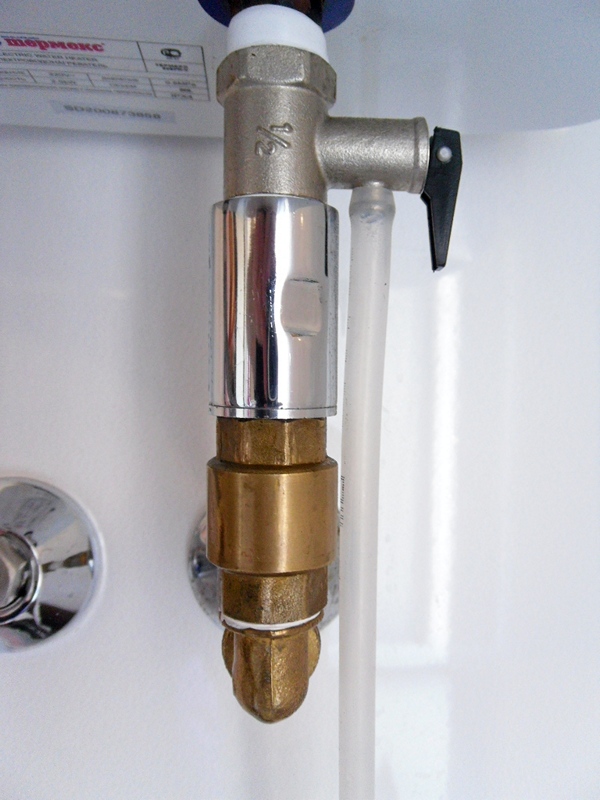
What are they needed for?
- The non-return valve prevents the heated water from draining into the cold water supply during water cuts. Thus, it saves thermal energy and, more importantly, eliminates the drying of heating elements in the tank;
- The safety valve is activated when there is a critical increase in pressure in the tank (during heating of water and the accompanying thermal expansion). Remember: the DHW supply and the boiler, thanks to the check valve, are a closed volume, and the water contained in it is practically incompressible. Therefore, its heating leads to a very rapid increase in pressure, which threatens to burst the storage tank or the DHW pipeline.
The heat exchanger of the indirect heating boiler is connected to the heating outlet. In summer, the heating circuit is turned off by valves, and the coolant circulates through a small circuit - between the boiler and the boiler.
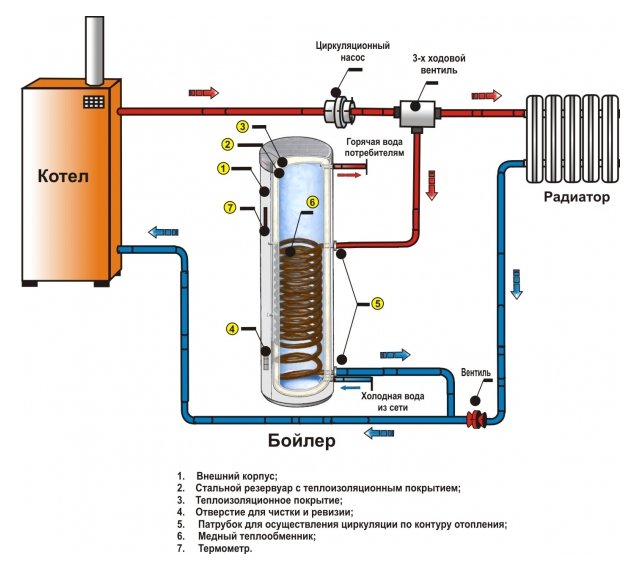
What should be considered when choosing a boiler?
- The volume is selected at the rate of at least 40 liters per family member. In this case, several people will be able to take a shower without waiting for a new portion of water to be heated;
- The ideal material for tank walls is stainless steel. Enamel as an anti-corrosion coating of black steel rarely lasts longer than 5-7 years, and the disease of steel tanks with a glass-ceramic coating is cracks in it during temperature changes;
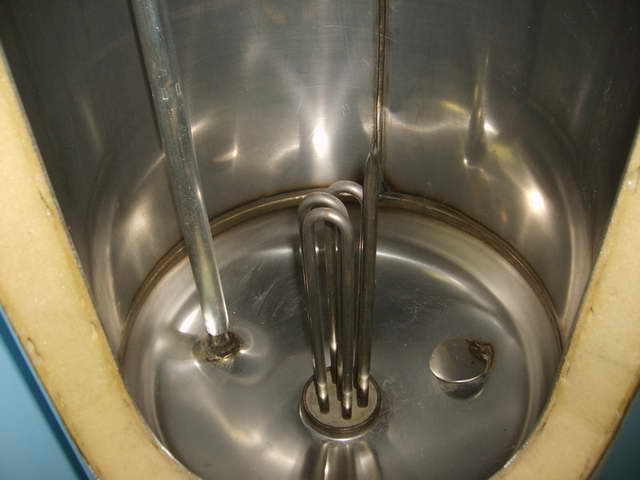
Tip: if you have a boiler with a steel tank and a glass-ceramic coating, limit the heating to a temperature of 50-60 degrees. Then storage water heater will last noticeably longer.
- A dry heating element (installed in a sealed flask) is more practical than a wet one, since to replace it you do not need to drain the water from the boiler tank;
- The greater the power of the heating elements, the less you have to wait for the heating of a new portion of water.
Note: power has nothing to do with the efficiency of the device. To heat its fixed volume, a certain number of kilowatt-hours of electricity will be required. The efficiency is affected only by the volume of the tank (a large boiler loses more heat through the walls) and the quality of its thermal insulation.
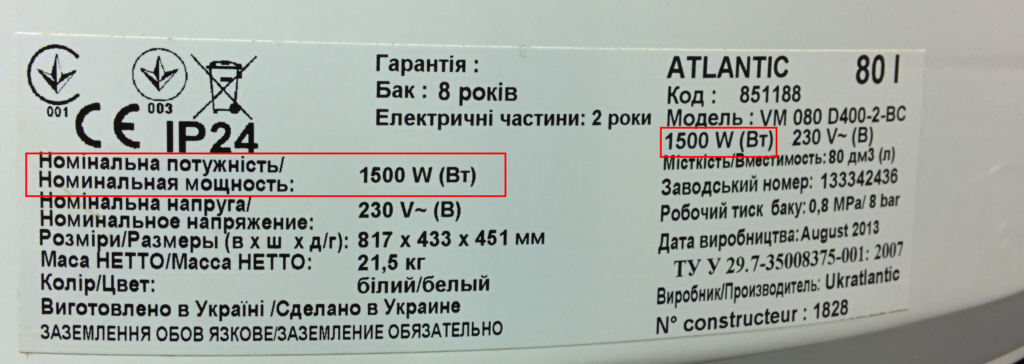
storage tank
How to implement water supply from a storage tank if you often have water cuts (as an option - it is supplied according to the schedule, which is typical for many garden cooperatives)? As a tank, polyethylene containers for drinking water are traditionally used.
The volume of the container is determined by two factors:
- Average daily water consumption;
Reference: according to current sanitary standards, an adult consumes about 200 liters of water per day.
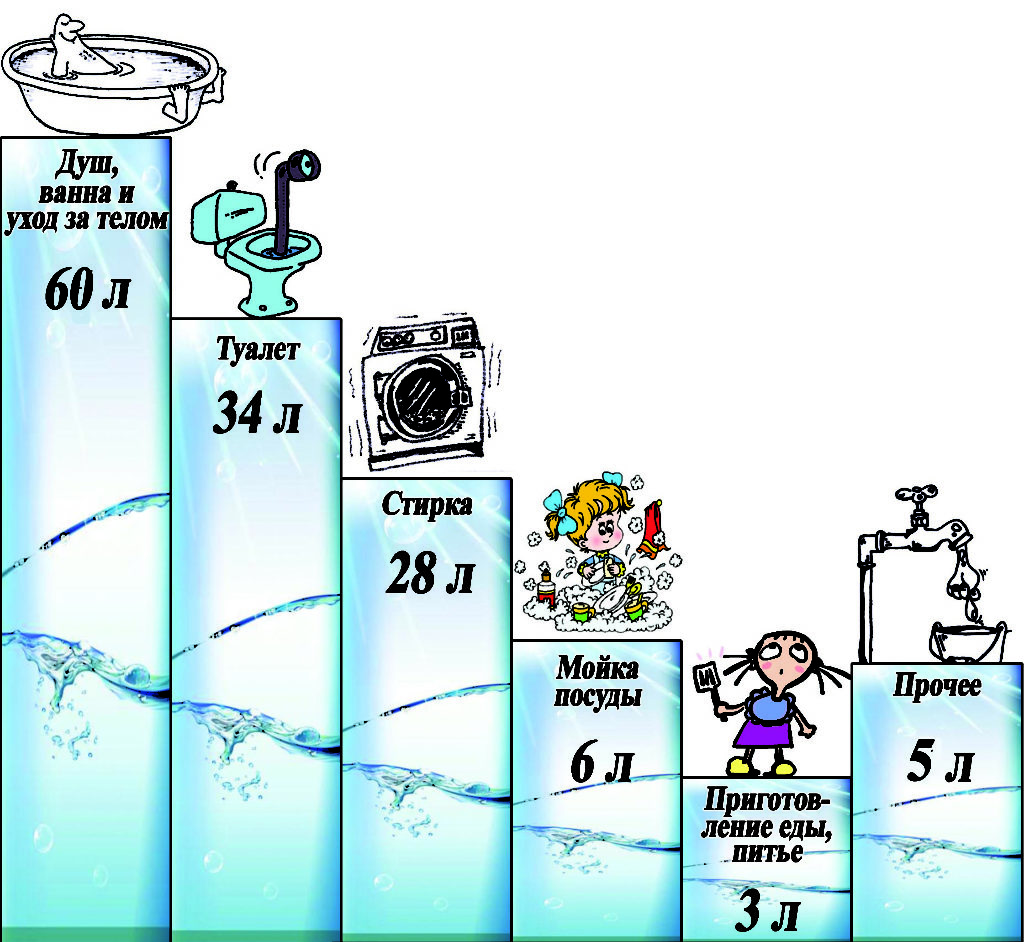
- The maximum duration of its outages. Let's say, for a family of three, when water is supplied according to the schedule twice a week, the maximum shutdown duration will be 4 days, and a reasonable minimum tank volume is 3x200x4 = 2400 liters.
How to connect the container to the water supply?
The instruction is not difficult:
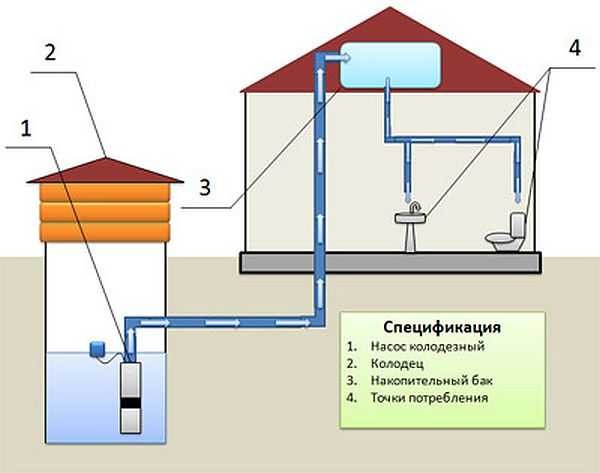
- A float valve is responsible for taking water into the tank and its timely shutdown - the same as those installed in toilet bowls;
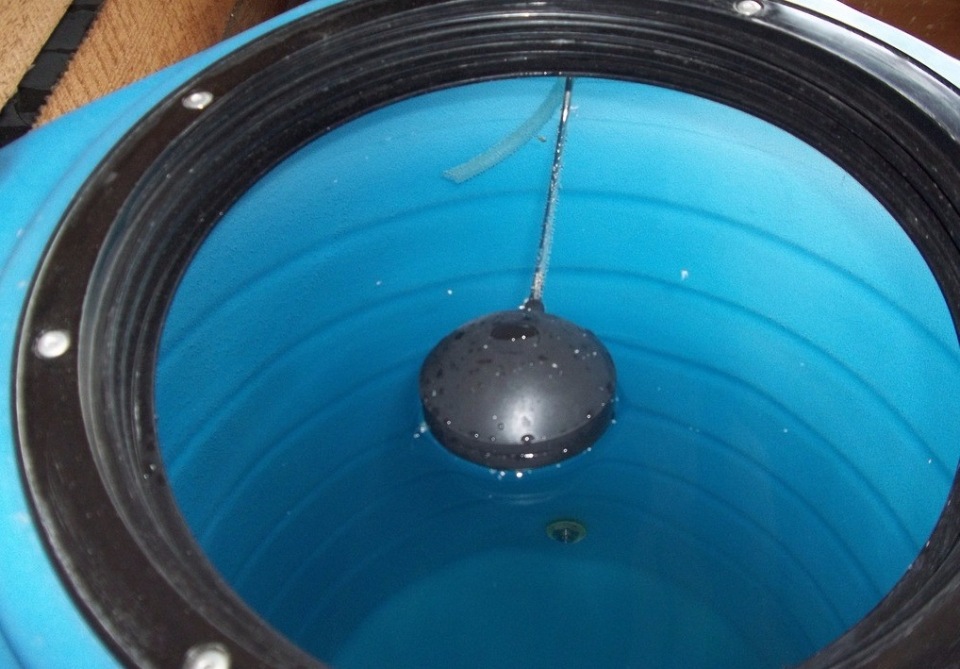
- The input of water supply to the house is laid below the level of soil freezing. For its installation, a pressure polyethylene pipe on compression fittings is usually used: with a diameter of up to 32 mm, their installation is done by hand, without tools;
- The water supply is connected to a regular pipe for draining water at the bottom of the tank. It is useful to install a ball valve between the tank and the pipe: it will allow you to turn off the water to repair the faucet or while you are away.
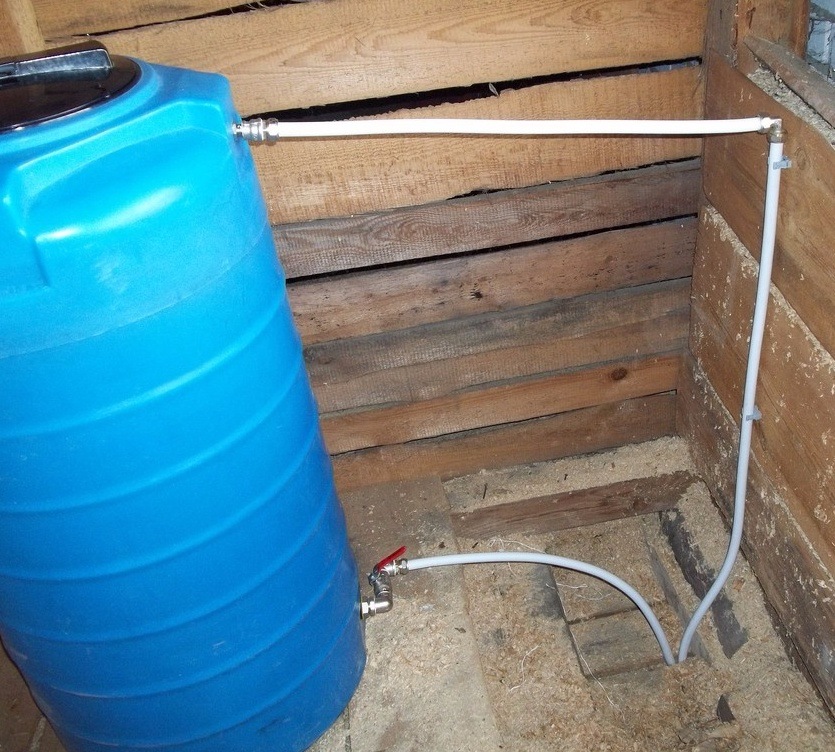
Conclusion
We hope that we were able to answer the questions that the reader has accumulated. To learn more about how water supply from a storage tank can be implemented, the video in this article will help you. Good luck!
Storage water tanks are great for organizing a summer shower at their summer cottage. Thanks to them, it is possible to ensure comfortable acceptance of hygiene procedures where this is not provided for by engineering systems. Such a shower, complete with a tank that can withstand high pressure, can be considered an essential, because outside the city you often have to not only relax, but also work. Therefore, periodically there is a need to wash off the dust and freshen up after a hard day.
Types and features of plastic tanks
The heating tank can withstand the pressure of water pressure and can have a variety of designs. The most common options are:
shower barrel,
traditional tank,
polymer tank,
complete cabin.
All options are characterized by different volumes and shapes. So, conventional tanks can be cylindrical and installed vertically or horizontally. Those containers that are designed to be used in tandem with showers have a square base and at the same time are capable of performing the function of a roof.
Some tanks are better suited for organizing a mobile shower, while others can be safely used to store water and then water the garden with it. In this case, both in the first and in the second case, polymer compounds are used as materials for the manufacture of containers. The heated plastic shower tank is usually offered in black, and for irrigation in white or blue to choose from. A distinctive feature of the tanks of the first type is the presence of heating elements in them, thanks to which you can get hot water under pressure in a short period of time, and not wait until its temperature rises under the rays of the scorching sun.
On average, the volume of the storage tank varies from 50 to 250 liters. When calculating the minimum required capacity, it is necessary to build on the number of people who will shower in succession, as well as whether the water will be used for tillage.
Advantages of plastic water tanks
Convenient to use. Such tanks are easy to install, connect to pressurized water supply systems, and transport over long distances.
Designed for multiple functions. You can use the tank for watering, taking water procedures and domestic needs.
Made from non-toxic materials. Health safety makes it possible to store drinking water in some models of containers.
Have a good margin of safety. Water tanks of a certain configuration easily tolerate pressure surges. Usually such containers are used in tandem with pumping equipment. The latter provides the pressure necessary to achieve the pressure.
durable. They serve for several decades without loss of initial performance. Will not corrode due to prolonged contact with pressurized water. They do not allow the appearance of an unpleasant odor, rotting and the spread of mold.
Easy to transport. Tanks are streamlined (especially cylindrical models) and light in weight. Models for installing a mobile shower can be easily transported on the roof of a car.
Our offer
Here you can buy high-quality tanks and other containers for water to the country in a large assortment of shapes, sizes and volumes. Single and double layer solutions are available, capable of working under pressure. All tanks are equipped with accessories for connecting a water delivery or pumping system: threaded fittings, float valves and inspection covers.
To make a purchase of any tank from the catalog of the EKVOLS online store, select the required number of items and add them to the "Basket". You can also make a quick order or call us at the phone number presented at the top of the page. We offer affordable prices for the entire range of products, including water storage tanks, and we deliver tanks and other polymer containers in Moscow, Moscow Region and the regions of the Russian Federation.
Often there are situations when an autonomous water supply system is the only source of drinking water in the house.
If the supply is interrupted due to a pump malfunction or a power outage, the entire house is left without water. The sewer does not work, there is no water in the tap.
In case of poor water supply, it is advisable to install a storage tank.
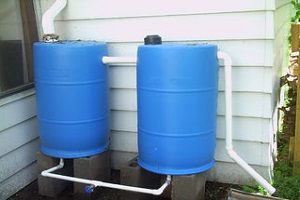 Water storage tanks are used to collect rainwater (for technical purposes), for the operation of the sewer system, for heating hot water, to create a supply of drinking liquid.
Water storage tanks are used to collect rainwater (for technical purposes), for the operation of the sewer system, for heating hot water, to create a supply of drinking liquid.
Modern water supply systems are designed in such a way that the pressure in them is maintained precisely due to the mass of water in the tank.
How it works
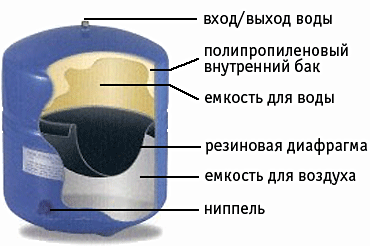 The tank consists of two chambers separated by a movable rubber partition.
The tank consists of two chambers separated by a movable rubber partition.
Water enters one compartment, pressure occurs on the partition, behind which there is an air chamber.
Air, compressing under the pressure of a stretching membrane, creates pressure in the system. The pump pumps water up to a certain level, then automatically turns off. When the pressure drops, it refills the water tank. Users can independently adjust the system for supplying water to the tank to create the desired pressure.
The need for water storage
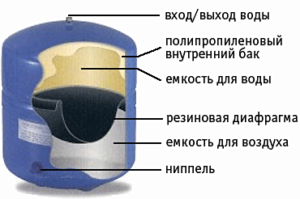 The local water supply system is used in cottages, country houses, in small businesses located far from the central systems.
The local water supply system is used in cottages, country houses, in small businesses located far from the central systems.
In an apartment of a multi-storey building, you can connect a small reserve tank.
The intermittent supply of water creates problems and inconveniences. This happens if water is supplied to the water supply for several hours a day. Another example is a well, the well does not have time to fill up with intensive water analysis.
In order not to depend on these conditions and use water constantly, a storage tank is included in the water supply system at home. It accumulates a supply of moisture and ensures its uninterrupted supply to the pipes.
With a minimum flow of water into the system, it will gradually accumulate, and then, if necessary, fully ensure consumption. In the hot water system, a thermal tank is also needed.
Mounting methods
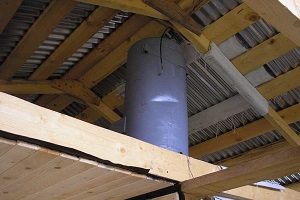 The water storage tank can be located in the upper and lower positions in relation to the plumbing system.
The water storage tank can be located in the upper and lower positions in relation to the plumbing system.
Often it is installed in the attic or attic floor. This is a kind of water tower.
Connecting such a system is convenient because a pump is not required to pump water out of the tank. This means that there is no dependence on electricity supply. Water flows by gravity under pressure through pipes to faucets.
The water pressure in this case will not be strong. If the tank is installed at a height of 1 m, then the water pressure in the pipes of the lower floor will be 1 atm. The washing machine will not be able to work at this pressure. But there will always be water in the tap. A drainage pipe must be cut into the bottom of the tank through which the sediment is removed.
It is worth noting: the storage tank has negative sides A: It takes up a lot of usable space, needs a good ceiling to install. In winter, the system needs to be insulated.
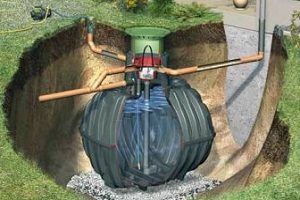 For those users who appreciate every meter of usable area, the underground placement of a horizontal storage tank is more suitable.
For those users who appreciate every meter of usable area, the underground placement of a horizontal storage tank is more suitable.
Bury it to a depth of 50-60 cm. Flowers or vegetables can be planted on top.
The important thing is that under the ground you can place a container of any size. Water is supplied from it by means of a pump. Without it, water will not enter the system. Repair and cleaning of the reservoir is difficult, since it will have to be freed from the ground before work.
Expert advice: to avoid deformation of the tank and its leakage, it is necessary to make a substrate of insulation under it. Then the freezing soil will not squeeze the walls.
If a plastic tank is installed in the lower position, then it must have a round shape. In this case, the loads and pressure on the shell are distributed evenly. In the upper part it is necessary to make a hatch for inspection and cleaning of the tank.
It is better to install it at a slight slope. Then the sediment will accumulate in one place, over which the hatch should be mounted. Through it, debris and sediment are easily removed using a pump.
Volume
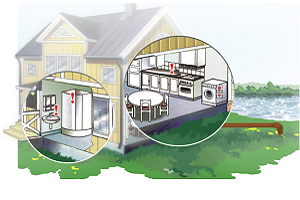 It is necessary to calculate the size of the tank in accordance with the need to use water in the house and on the site (for example, for irrigation).
It is necessary to calculate the size of the tank in accordance with the need to use water in the house and on the site (for example, for irrigation).
It is necessary to focus on the average data of a house with all amenities - a kitchen sink, Dishwasher, in the bathroom - toilet, shower, bath, sink and washing machine. For 1 day, 180-210 liters of water are consumed per person. At the dacha without a soul and household appliances costs are reduced by almost 2.5 times.
Note: when installing the tank, you should take into account how much water passes per day from the water supply.
The volume of the container must not exceed this volume. If interruptions in water supply are a rare problem, then “just in case” you can have a small tank.
Material and installation features
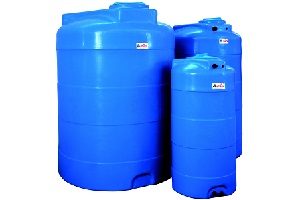 The walls of the tank should not release harmful substances into the water and should serve for a long time.
The walls of the tank should not release harmful substances into the water and should serve for a long time.
Therefore, such containers are made of food-grade stainless steel or food-grade polypropylene.
The hot water tank is always metal. The plastic tank is used for cold water.
A valve with a float or a float valve of the pump is inserted near the filling pipe (if the water comes from a well, and not from a water pipe). If the mechanism breaks, excess water goes into the tube that goes down the drain. It is installed below the inlet pipe.
A filter is attached to the filling hole to trap suspended matter and particles of sand and dirt. If the tank shell is opaque, then you need a level that determines the amount of water in the tank.
It is impossible not to appreciate the importance of storage tanks, especially for private houses. Having such a tank, you can safely use water all year round, regardless of the stability of the water supply in the water supply system. The design and installation is quite simple, which is also an additional advantage.
Watch the video in which the user shares his experience of installing a water storage tank:

